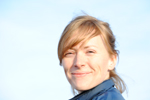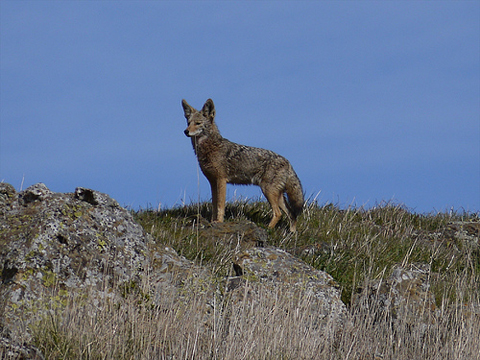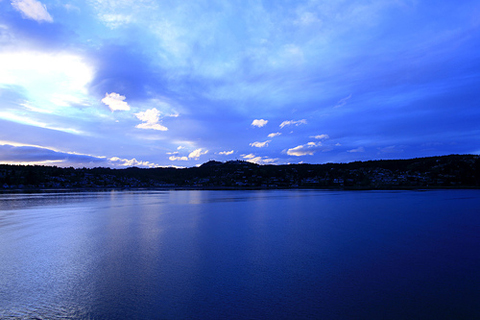Field Trip: A first foray into real-time science reporting
The wind was whipping as we stood on a ridge two thousand feet over Stanford University, fiddling with video equipment and preparing to talk environmental conservation with an economist.
Julia, my partner in this experiment, was worried about our audio quality. I, on the other hand, was focused on the time. We had to get our subject, Marc Conte, an economist with the Natural Capital Project, back to Stanford for a seminar by noon. It was 10:30 a.m. Already, we’d spent an hour-and-a-half winding six miles up Alpine Drive and hiking through the winter slop to reach a vista that could illustrate the important points of Conte’s work on ecosystem services.
A laptop, some wires and a microphone lay scattered on the grass, out of place in the sprawling open space. Julia leaned her ear to the camera and frowned at the garbled noise she heard coming through the lapel mic. Marc, not sharing her technical concerns, pointed out a coyote commanding a nearby hilltop with its silhouette. And I, as the designated interviewer, wondered how I might get Marc to talk about things like “mechanism choice” and “service provision” in a blog-friendly way.
We had hauled ourselves out of bed and up Russian Ridge with the goal of kick-starting our Science, Upstream experiment.
The idea to report science in real-time wasn’t strictly our own. Other, more veteran members of the science writing community have been calling for a more bloggy approach to the craft for years. John Rennie, whom we’re honored to call a neighbor on PLoS Blogs, and Thomas Hayden, one of our professors here in the Stanford Graduate Program in Journalism, are notable influences from that bunch. But as we’ve moved through the initial phases of this endeavor, past several false starts, I think it’s fair to say we’re feeling more ownership of it. And a big part of that feeling is owing to our discovery of the group we think will make an ideal subject.
The Natural Capital Project is a coalition of academic earth scientists and economists, and non-profit environmental groups trying to promote smarter land-use decisions by identifying the services that ecosystems provide and attaching economic value to them. In other words, they’re trying to help preserve nature by shifting it from the category of “priceless” to something that is clearly, quantifiably valuable in the strict economic sense. It’s only by giving nature a dollar value, they say, that we’ll actually value it enough to preserve it.
The concept of “ecosystems services” was pioneered almost thirty years ago, largely by Stanford’s Paul Ehrlich and Hal Mooney. Then, about 15 years ago, Robert Costanza, formerly of the University of Maryland, brought economists to the issue in a paper that estimated the total value of the world’s ecosystems services to be $33 trillion In 1997, that sum was almost double the gross national product of all countries combined. Some questioned that dollar value’s accuracy, but the paper’s debut in Nature [pdf] generated enormous interest in the field.
Stanford has been a primary hub in the world of ecological economics for more than a decade, but it was only in 2006 that Stanford’s Gretchen Daily founded the Natural Capital Project with collaborators in Seattle and Washington, D.C. Today, the project partners with the World Wildlife Fund, Institute for the Environment at the University of Minnesota, and The Nature Conservancy, and its connections dot the globe from California’s Sierra Nevada to Chile’s Northern Andes to China’s Upper Yangtze River Basin. These far-flung participants often pass through the Farm, as we refer to our sprawling campus, where they learn new techniques to implement in their home countries.
Many come to Stanford to gain a working knowledge of the Natural Capital group’s signature software program, called Integrated Valuation of Ecosystem Services and Tradeoffs. InVEST is an open-source program, currently accessed through ArcGIS, and an attempt to codify the theory of ecosystems services. InVEST consumes several pieces of information about a landscape, including land cover, topography, soil type and human infrastructure. Using that information, it provides estimates of service quantity and value, displayed as maps. Users can then visualize the impacts of different land-use scenarios, which might lead to policy or decisions like: “We should not let the cattle graze on the steep slopes where streams form,” or “We should log here, where it will have the least impact on erosion.”
Over the next several months, we plan to follow the Natural Capital project as its members go about their regular work. We’ll be there as they expand this software’s capabilities, and use it to weigh the economic value of conservation versus deforestation in the Amazon, of preserving China’s forests as a way to prevent sediment from building up at dams, and, later this spring, of maintaining forested areas around US military bases. We’ll also follow the group as it tests its models on marine ecosystems [pdf] for the first time, on Vancouver Island.
And finally, we’ll report on the human story of the collaborations the project is constantly undertaking. As individuals pass through Stanford, we’ll capture them in brief profiles that we hope will illuminate the project and how it works—and perhaps say something deeper about the nature of research, collaboration and turning theory into applications in the process.
This was our goal in dragging Conte up Russian Ridge on a wintry morning. Though we did not, in fact, return him to campus in time for his noon seminar, we satisfied ourselves with the trip’s smaller victories: the discovery that a zipped-up jacket can substitute just fine for a forgotten microphone windscreen; the gradual easing, as the sun crept higher in the sky, of Conte’s speech from economist into English; and our deeper understanding, with each interview and outing, of this complex scientific endeavor.
Photo credits:
Flickr / randomtruth
Flickr / justinjfj
Who is Science, Upstream?
 JAMIE HANSEN has written for Sierra Magazine, the High Country News, and Birders’ World. She’s pursuing a master’s degree in journalism at Stanford, hoping to tie together two passions: a keen interest in the natural world and communicating with broad audiences. She has a bachelor’s degree in English from Oberlin College, but fell in love with biology during her last semester.
JAMIE HANSEN has written for Sierra Magazine, the High Country News, and Birders’ World. She’s pursuing a master’s degree in journalism at Stanford, hoping to tie together two passions: a keen interest in the natural world and communicating with broad audiences. She has a bachelor’s degree in English from Oberlin College, but fell in love with biology during her last semester.
 JULIA JAMES is a master’s candidate in Journalism at Stanford University. She often writes about issues relating to human and environmental health. When not chained to a computer, she likes to climb rocks and chase Frisbees. She holds a B.S. in geological and environmental sciences (also from Stanford) and lives in Palo Alto with six housemates and five chickens.
JULIA JAMES is a master’s candidate in Journalism at Stanford University. She often writes about issues relating to human and environmental health. When not chained to a computer, she likes to climb rocks and chase Frisbees. She holds a B.S. in geological and environmental sciences (also from Stanford) and lives in Palo Alto with six housemates and five chickens.


[…] that’s not about results, but rather about personalities and processes: Science, Upstream // WHAT TO DO NOW? Post a comment or leave a trackback: Trackback […]
[…] Science journalists Jamie Hansen and Julia James experiment with “real -time science reporting“. […]